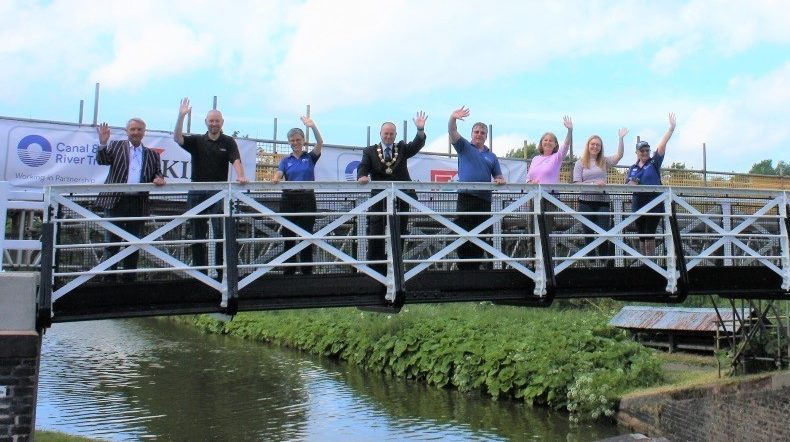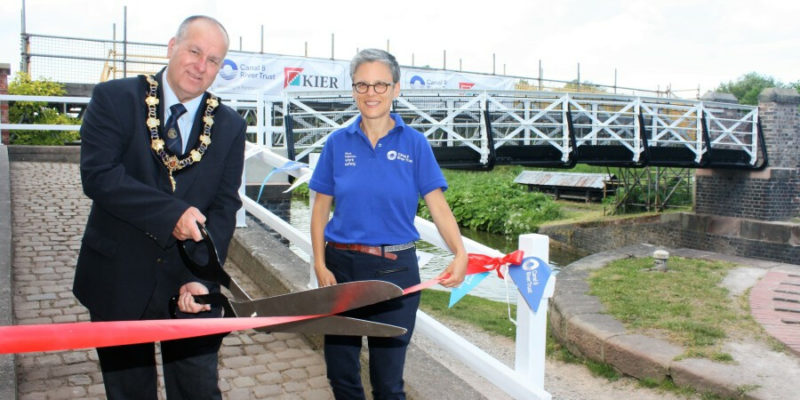de Havilland Fabrication & Welding were winners of the structural engineering awards in 2021 and 2022 from the Institue of Structural Engineers in the category Heritage/Bridge award for the Big Lock Footbrige in Middlewich, Cheshire.
The Bridges Award for New Life (<£5million): Big Lock Footbridge
Background
Big Lock Footbridge is a Grade II listed heritage structure built in the Victorian era. It is owned and maintained by the Canal and River Trust (The Trust) and has played an important role in the town historically and financially. The bridge is still a vital community link between the east and west sides of the Trent and Mersey Canal.
The bridge is at the heart of the local community, connecting people to the town centre, recreation areas, sports clubs, as well as businesses. Additionally, the bridge is adjacent to ‘The Big Lock’ pub and restaurant and is central to the Middlewich Folk and Boat festival, an annual event attended by over 30,000 people and 400 boats to celebrate the town’s industrial heritage. The Trust was committed to ensuring that a key part of the town’s history is well preserved for the future. Arcadis was appointed
to provide a full renovation of the bridge deck, abutments, and approaches with minimal intervention to meet its original appearance and harmony with the existing environment. The project started in April 2019 and the bridge was reopened in June 2021. The overall value for the restoration of the bridge was £330,000.
New Life Refurbishment
Before refurbishment, the bridge was in poor condition. It had been condemned, closed, and replaced with an adjacent scaffold bridge. Collaboratively, the Trust and Arcadis provided a sympathetic restoration design which could achieve the modern-day loadings and safety standards and bring the structure back to its full operational status for the benefit of the local community. To provide the required live load capacity of the structure, the u-frame stiffness of the bridge needed to be improved. To keep the heritage of the structure, a Victorian styled curved u-frame was added to every existing bay of the bridge truss.
To undertake the restoration work, the bridge was lifted out of position, a challenge which required a bespoke steel cradle due to the nature of the crumbling structure and to avoid any contamination to the surrounding environment. In the workshop, the structure was grit blasted prior to finalising design details and fabrication. The bottom plan bracings were restored, and connections upgraded to ensure lateral wind loads could be carried by the deck. The original Victorian elements were retained to the maximum extent possible, only being replaced where necessary for strength or safety reasons. Where replacement was required, the unique historical features were closely replicated, such as the heavily corroded post bases and damaged parapet infill rails. The design ensured minimal expenditure on new steelwork, and the appearance of the bridge remains largely unchanged besides the addition of the new u-frames.
Low maintenance, cost-effective elastomer pad bearings were provided to guarantee adequate support to the structure and relieve longitudinal deck movement stress from the abutment walls. The elastomeric bearing pads being of rubber only (no metal inserts) are not expected to need replacement in the next 100-years.
A fibre reinforced plastic (FRP) Polydeck system was proposed as a lightweight deck material to replace the existing heavy concrete deck, reducing the permanent load of the structure. FRP is a modern, durable, and economic material which has an elegant appearance, and provides a long-lasting maintenance free deck system. The deck structural elements are painted in a black anti-graffiti finish, matching the original colour scheme, and decreasing any future repainting costs.
The existing parapets were deemed to be climbable, and as such Arcadis worked in collaboration with the Trust and the fabricator (De Havilland) to provide a mesh panel that could be connected to the existing bridge parapets to mitigate this risk. The panel is the same woven mesh used at the Eden Project and is so light in appearance that it appears to be invisible when viewed from a distance, allowing the structure to appear very much as it did originally.
Many local residents came out to watch as the newly restored bridge was craned back into position, one year after restoration works began, including a couple who had gotten engaged on the bridge many years ago. One man played the penny whistle as the bridge was lifted into place and another man stood watching with a parrot on his shoulder. It was an exciting moment for the community with people lining the apartment balconies looking over the bridge and gathered at the adjacent pub and towpath to
cheer as the councillor officially opened the refurbished bridge.
Outcome
Arcadis,The Trust, the contractor, and the fabricator, rose to the challenge of providing a new life for Big Lock Footbridge. The successful collaboration resulted in a sympathetic restoration of an elegant Victorian structure, which is a key part of the town’s history that will now continue well into the future for the benefit of the local community.


